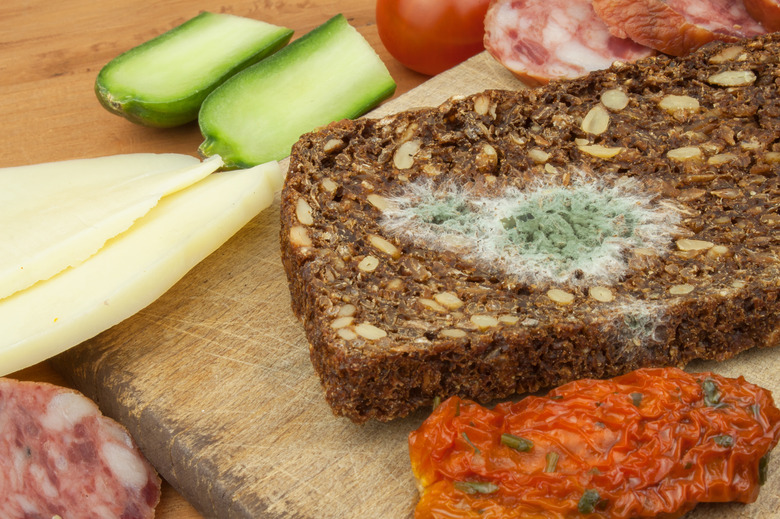How Does Mold Grow On Food?
Mold spores are everywhere, and many strains grow on food. The spores anchor in bread, cheese, meat and fruit and grow into fruiting bodies that appear as dark, sometimes fuzzy blotches. Some benign strains, such as Penicillium roqueforti, which grows on blue cheese, are actually desirable, but others can cause allergic reactions. Some strains produce mycotoxins and aflatoxins, which can make you sick. Mold grows inside food as well as on the surface, so it isn't safe to simply cut it off. Unless you're making or storing cheese, it's best to discard moldy food.
Conditions for Mold Growth
Conditions for Mold Growth
Mold needs four things in order to grow: water, food, suitable air quality and temperature. Food that contains any kind of water or fluid is susceptible to mold growth. In addition, mold can only grow if it has food readily available to feed itself and grow. Mold is a fungus that feeds off of dead or dying organic matter, and can be destructive to your health and food quality. Mold will grow best in damp, dark and cool conditions, but can also grow in warmer temperatures as well. Mold grows best between 55 to 70 degrees Celsius.
How Mold Grows on Food
How Mold Grows on Food
Tiny mold spores are all around us in the air, which is not harmful to our health in moderation. Once a spore lands on a surface, it searches for water and nutrients to feed off of. Food is able to grow mold easily because it is often kept in the perfect environment to foster mold growth. The temperature is usually about right, air quality is good, and the food itself provides the nutrients and water the mold needs in order to grow. As the spore takes root, it begins to spread and create more spores and spread quickly on the surface of your food. Some molds can take over your food in a matter of 12 to 24 hours, while others may take weeks.
Dangers of Mold on Food
Dangers of Mold on Food
Mold can be very dangerous if eaten. Mold is perhaps most common on bread, cheese, and fruits and vegetables left out in the kitchen. Eating mold on any item has the potential to make you very sick. Simply cutting off the moldy part does not render the food safe to eat. Mold has the ability to penetrate deep into the food and not just fester on the surface. If you do spot mold on your food, it is best to inspect the entire serving and not just one spot. In addition, if the food you are eating is part of a package of multiple servings, you should check all of them – mold can spread very quickly and infest an entire package of food.
Cite This Article
MLA
Farrelly, Lauren. "How Does Mold Grow On Food?" sciencing.com, https://www.sciencing.com/why-does-mold-grow-food-4966797/. 13 March 2018.
APA
Farrelly, Lauren. (2018, March 13). How Does Mold Grow On Food?. sciencing.com. Retrieved from https://www.sciencing.com/why-does-mold-grow-food-4966797/
Chicago
Farrelly, Lauren. How Does Mold Grow On Food? last modified March 24, 2022. https://www.sciencing.com/why-does-mold-grow-food-4966797/
